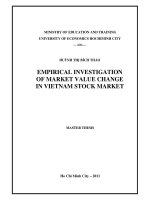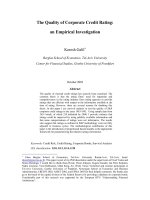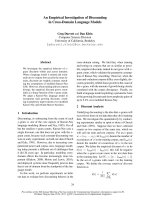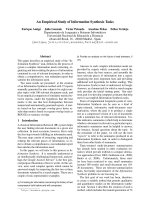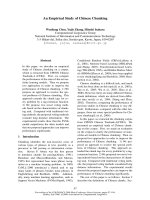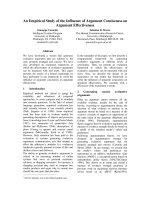An empirical investigation of personal characteristics significantly affecting employment offers from international accounting firms to accounting graduates
Bạn đang xem bản rút gọn của tài liệu. Xem và tải ngay bản đầy đủ của tài liệu tại đây (14.64 MB, 222 trang )
University of Arkansas, Fayetteville
ScholarWorks@UARK
Theses and Dissertations
5-1983
An Empirical Investigation of Personal
Characteristics Significantly Affecting Employment
Offers from International Accounting Firms to
Accounting Graduates
John M. Alvis
University of Arkansas, Fayetteville
Follow this and additional works at: />Part of the Accounting Commons
Recommended Citation
Alvis, John M., "An Empirical Investigation of Personal Characteristics Significantly Affecting Employment Offers from International
Accounting Firms to Accounting Graduates" (1983). Theses and Dissertations. 3121.
/>
This Dissertation is brought to you for free and open access by ScholarWorks@UARK. It has been accepted for inclusion in Theses and Dissertations by
an authorized administrator of ScholarWorks@UARK. For more information, please contact
AN EMPIRICAL INVESTIGATION OF PERSONAL CHARACTERISTICS
SIGNIFICANTLY AFFECTING EMPLOYMENT OFFERS
FROM INTERNATIONAL ACCOUNTING FIRMS
TO ACCOUNTING GRADUATES
AN EMPIRICAL INVESTIGATION OF PERSONAL CHARACTERISTICS
SIGNIFICANTLY AFFECTING EMPLOYMENT OFFERS
FROM INTERNATIONAL ACCOUNTING FIRMS
TO ACCOUNTING GRADUATES
A dissertation submitted in partial
fulfillment of the requirements for
the degree of Doctor of Philosophy
By
JOHN M. ALVIS, B.S., M. A.
Jacksonville State University, 1969
University of Alabama, 1974
May, 1983
The University of Arkansas
- ii -
ACKNOWLEDGEMENT
My sincere thanks to Professor Doris M.
of my thesis committee,
Her cheerful
for
Thomas W.
be
Jones,
friends
in
one would
Professors James P.
consider normal
Modisette and
both on my thesis committee, have proved to
addition to
Indeed these
endeavor.
chairwoman
her encouragement and advice .
help exceeded what
under any circumstances.
Cook,
tireless
three
supporters
professionals are
of
this
special
people.
To my late Father,
I give
thanks for teaching me to see
humor in all of life; to my Mother,
to my brothers and
to excel;
friends;
to my wife Gail,
to my sons,
for giving me the desire
sister,
for being such loyal
for showing me love and patience;
Johnny and Allen,
for giving me purpose.
- iv -
CONTENTS
Chapter
1.
page
INTRODUCTION
........................................................................................................
1
NATURE OF THE PROBLEM........................................................................... 3
The Faculty’s Perspective ........................... .....
3
The Recruiter's Perspective ................................. ...
4
The Student's Perspective...........
6
OBJECTIVES OF THE STUDY.......................................................... 7
HYPOTHESES TO BE TESTED................................
10
RESEARCH METHODOLOGY ........................................................................... 11
JUSTIFICATION OF THE STUDY.................................................... 14
LIMITATIONS OF THE STUDY......................................................... 16
PLAN OF THE STUDY......................................................................... 18
2.
THE CHARACTERISTICS UNDER REVIEW
.
.....................................
.
19
THE INTERVIEWING PROCESS ................................................................. 19
The Campus Interview
................................................................. 21
The Office Visit
...... ............................................ 23
LITERATURE RELATING TO CHARACTERISTICS FOR STUDY . 25
Business Viewpoint.....................................
26
Opinions of Students
.....................................................................27
Opinions of Accounting Firm Recruiters
.... 29
The Seaton and White Study ............................................... 29
The Murdock Summary
............31
SELECTING THE CHARACTERISTICS FOR STUDY
..... 31
The Initial Survey
................................. ....... 32
The Follow-Up Survey
.............33
Review of Candidate Evaluation Forms
..... 36
An Example of Candidate Ratings ........ 41
Survey of Student Recruitment Files ........................... 41
PREPARATION OF QUESTIONNAIRE ...................................................... 43
Personal Data .......... ................................. 44
Activities
..... ................................. ......45
Academic Data...........................................................
46
Overall Courses
................................. .......47
Accounting Courses ................................................................. 47
English
............................ ..... ................................. 48
Other Data . ........... . . . . . 48
Self Evaluation ............................................................ ....49
Profile Data
...........................................................................................51
SUMMARY................................................................................................................ 51
v
3.
RESEARCH METHODOLOGY
..................................................................................
53
THE TYPE OF STUDY.......................................................................................53
SPECIFIC RESEARCH OBJECTIVES ....................................................... 55
Objectives 1 and 2
. . ......................................... .....55
Objectives 3, 4, and 5
..56
Objective 6..................58
Objective 7...........................
..58
Objective 8 ....................... .............59
A General Profile of Successful Applicants
. . 59
STATISTICAL TECHNIQUES ....................................................................... 60
Discriminant Analysis .. ............................................. ..61
Major Stages of Discriminant Analysis
... 65
Sample Division
..............66
Unstandardized and Standardized Models ... 68
Classification Matrices
... ....................... ..69
Probability of Group Membership
............................ 71
Multiple Regression ........................................................................ 71
Chi-Square Tests
....................................................................... .72
DEPENDENT AND INDEPENDENT VARIABLES
................................. 75
THE DATA COLLECTION PROCEDURES...................................................... 79
Selection of the Universities.................................................83
The Sample Selection
.................................................................. 83
SUMMARY.................................................................................................................. 86
4.
RESULTS
AND INTERPRETATION OF RESEARCH
.................................
88
HYPOTHESIS 1....................................................................................................... 90
The 0.001 and 0.010 Significance Levels .... 92
The 0.050 Significance Level
............................................. 97
The 0. 100 Significance Level
........
100
HYPOTHESIS 2 . ........................................................................................... 101
HYPOTHESIS 3......................................
105
The 0.001 and 0.010 Significance Levels ...
108
The 0.050 Level of Significance .................................
110
The 0.100 Level of Significance .......
113
HYPOTHESIS 4............................................................
115
Comparison of Models
. .........................................
118
Functions and Variables for Hypothesis 4
. .
120
HYPOTHESIS 5.....................................................................................................125
HYPOTHESIS 6..............................................................................................
126
Tests of Significance...........................................
129
Variables for Hypothesis 6
129
HYPOTHESIS 7..............................................................................................
132
The Primary Reason
... ....................... .....
133
The Secondary Reasons ............
135
HYPOTHESIS 8............................................................
137
CHARACTERISTICS AND VIEWPOINTS . .......................................
139
The Successful and Unsuccessful Student ...
139
The Successful Male and Female Student
...
145
SUMMARY................................................................................................................149
- vi -
5.
SUMMARY AND CONCLUSIONS.............................................................................. 154
SUMMARY
.............. ...........................
CONCLUSIONS
.....................................................................
Hypothesis 1..........................................................................
Hypothesis 2 ................................................... ......
Hypothesis 3 ................................................... ......
Hypothesis 4 ................
Hypothesis 5 ........ ........................ ...
Hypothesis 6
Hypothesis 7..............................................
Hypothesis 8.........................
Profile ...... ............................................ ....
Comparison to Other Studies ...........................................
Limitations ...........................................................................
IMPLICATIONS................................................................................
RECOMMENDATIONS FOR FUTURE RESEARCH
......
Appendix
154
158
158
159
160
162
164
164
165
166
166
167
169
169
173
page
A.
CORRESPONDENCE
B.
QUESTIONNAIRE................................
188
C.
EXPANDED STATISTICAL DISCUSSION ..........
192
DISCRIMINANT ANALYSIS
..... ......................................
Assumptions of Discriminant Analysis
....
Problem Areas ........ ......................................
Nonnormality ............................ .........
Multicollinearity
............
Unequal Dispersion Matrices
.......
MULTIPLE REGRESSION
.......................................................................
192
195
195
195
197
197
199
D.
.....................................................
EXPANDED USE OF DISCRIMINANT MODELS .
176
......................................... 202
SELECTED BIBLIOGRAPHY .......................................................................................
- vii -
205
LIST OF TABLES
Table
page
1.
Factors in Obtaining Employment
2.
Importance of Factors as Viewed by Students
3.
Characteristics Sought in New Employees by CPA Firms 30
4.
Characteristics Considered by Recruiters - Southwest
Region
....... ...................... .........33
5.
Characteristics Considered by Recruiters - Midwest
Region..........................
-...............................35
6.
Probable Grouping of Other Characteristics .....
7.
Information from Coopers & Lybrand Candidate
Evaluation Form................................
8.
Communication Skills Described on Candidate
Evaluation Forms
.................................................. ......38
9.
Leadership Qualities Described on Candidate
Evaluation Forms
..... .......................................................
10.
Personal Qualities Described on Candidate Evaluation
Forms .... .. .
...........................................................................39
11.
Motivation as Described on Candidate Evaluation
Forms ......................40
12.
Technical Qualities Described on Candidate
Evaluation Forms
. ...............40
13.
Hypotheses and
14.
Analysis of Responses from
15.
Unstandardized Discriminant Functions for Hypothesis
1...........................
91
16.
Standardized Discriminant Functions Derived for
Hypothesis 1
.... ...................... .........92
..................................................
Research Methodology
....
28
36
...37
39
........87
the Southwest Region
- viii -
27
.
.
90
17.
Classification Matrix for Hypothesis
0.010
1:
0.001 and
18.
Classification Matrix for Hypothesis
1:
0.050
99
19.
Classification Matrix for Hypothesis
1:
0.100
101
20.
Discriminant Function for Hypothesis 2:
0.100
103
21.
Unstandardized Discriminant Functions for Hypothesis
106
3
22.
Standardized Discriminant Functions for Hypothesis
3
107
23.
Classification Matrix for Hypothesis 3:
0.010
0.001
109
24.
Classification Matrix for Hypothesis 3:
0.050
113
25.
Classification Matrix for Hypothesis 3:
0.100
115
26.
Unstandardized Discriminant Functions for Hypothesis
4
117
27.
Standardized Discriminant Functions for Hypothesis
4
117
28.
Classification
0.010
29.
Classification Matrix for Hypothesis 4;
0.100
30.
Supply and Public Accounting Demand for Graduates
127
31.
Standardized Coefficients and Other Data for
Hypothesis 6
129
32.
Primary Reasons for Selecting Accounting as a
Career
134
33.
Second Most Important Reasons for Selecting
Accounting
136
34.
Third Most Important Reasons for Selecting
Accounting
137
35.
Chi-Square Test of Homogeneity
138
36.
Selected Characteristics of All Candidates
140
37.
Selected Viewpoints of All Candidates
143
Matrix for Hypothesis 4:
ix
0.001
and
and
0.050 and
95
121
124
38•
Selected Characteristics of Successful Candidates
146
39.
Selected Viewpoints of Successful Candidates ...
148
40.
Breakdown, of Employment Offers by Areas of Entry .
149
41.
Probability of Group Membership
203
............................................
LIST OF FIGURES
Figure
page
1.
Interview Relationships..........................
2.
The Campus Interview
3.
Two-Group Discriminant Analysis ...........62
3
................20
-
X
-
Chapter 1
INTRODUCTION
students
accounting
Many
with
employment
an
the
firms to be superior to that
local accounting firms.
Some of
experience.
in-house training
accounting
public
firm
accounting
international
valuable professional
consider
view
offered
by
as
a
these students
international
available at many regional and
Many of
these students are of
the
opinion that an exposure to the variety and the magnitude of
operations of the international clientele is,
in itself,
an
educational experience without egual.
While some accounting students are desirous of employment
with an international firm because of its financial rewards,
many are
These latter
and the
or,
psychological rewards
interested in the
rewards include such
with an
prestige of employment
perhaps,
things as
as well.
the enjoyment
international firm
the opportunity for service to the accounting
profession ultimately at the
national and the international
level.
Other
accounting students
are
with an international firm because
-
1 -
attracted to
employment
of the continuing demand
for qualified, entry-level personnel.1 They view this demand
as an indication of job security and mobility in a period of
time when unemployment is a national problem.
students seek
this experience with the
if the employment
and their
them
to
does not prove to
firm,
they
The
employment rather easily.
Some of these
understanding that,
be mutually satisfying
will
be able
to
change
conventional wisdom is that
large public accounting firm to a
it is easier to go from a
smaller public accounting firm or industry than vice versa.
many
Whatever the reasons,
seek
employment with
accounting students actively
international public
the
accounting
firms.
This
seeking
chapter discusses
the
nature
employment
an
international
of the
objectives
tested,
the
limitations,
with
study
research
at hand,
the
methodology,
of the
problem
firm,
hypotheses to
the
of
the
be
justification,
and the plan of the study.
1 James
H.
MacNeill
and Mary
McInnes,
The
Supply
of
Accounting Graduates and the
Demand for Public Accounting
Recruits:
1979,
American Institute of
Certified Public
Accountants (New York: 1979), p. 21.
- 2 -
NATURE OF THE PROBLEM
Several
students
relationships
engage
in
the
1.
Figure
1:
into
pursuit
firm.
international accounting
are shown in Figure
come
of
The
play
as
employment
accounting
with
an
typical relationships
Interview Relationships
The Faculty’s Perspective
Students occasionally ask accounting
information
and advice
international firms.
pertaining to
Frequently the
- 3 -
faculty members for
employment with
questions center
the
on
these
what
accounting firms
public
entry-level employees.
identify the
to
recruiters
for
international
the most
for
in
faculty members are asked
characteristics which
if not
important,
That is,
looking
are
are
accounting
important,
viewed by
the
to
be
firms
when
considering
undergraduate accounting students.
Similarly,
concerning
students,
recommendations.
the
point
members
can
to
even
Faculty
recommendations or information that is
many cases.
from the faculty
recruiters request opinions
The responses by
of
specific
only
offer
general in nature in
faculty members may be based
on their observations and outdated experiences from personal
accounting and/or
educational backgrounds which may
not be
relevant in a changing employment market.
faculty is required
A certain amount of generalization by
because
nature
the questions
and
the
time
are
themselves
devoted
usually general
advising
to
conferring with recruiters is necessarily
were
a
research
accounting faculty
effort designed
to
members would be
explore
able to
and
students
limited.
in
If there
this
area,
offer better,
more-timely advice to students and recruiters.
The Recruiter’s Perspective
Each
of
the
international
accounting
basically similar characteristics and
employees,
and each
firm
follows
- 4 -
firms
desires
qualifications in new
similar approaches
to
attract qualified entry-level applicants.
The decision to
consider further a particular applicant generally rests with
the
representing his accounting
individual campus recruiter
firm.
interested in
recruiter is
The
making a
decision
which is best for his firm.
No one
decide
can anticipate
in
all
since the
cases
individual matter.
perfectly what
process
will
is
an
for recruiters
to reach opposite decisions
It is always possible that an
involving the same applicant.
might
decision
always possible
It is
from different accounting firms
individual recruiter
a recruiter
offer
an average
employment to
entry-level applicant when his firm is experiencing a period
of growth,
and demand for new professional staff is strong.
same recruiter
might
choose not to offer employment to the same applicant,
if for
Under
different circumstances,
overhiring
example
the
occurred
had
in
a
previous
period.
some firms may choose
to hire an exceptionally
qualified applicant whether or not
a current need exists in
Conversely,
the firm.
compete with one another
All accounting firms
in
excess of
one-fourth
students.2 Accounting firms
money
in their
efforts to
2 MacNeill and Mclnnes,
20-21.
of
all undergraduate
spend a great deal
attract qualified
to employ
accounting
of time and
applicants.3
Supply of Accounting Graduates,
pp.
3 For
example,
Robert
Pivik,
the
National Partner
for
Firmwide Planning and Development
with Deloitte Haskins &
Sells,
stated,
"Recruiting
is costly in terms
of time.
- 5 -
While
these costly
study in
this area might
serve as a
for those firms that wish
and thus the cost,
seem necessary,
recruiting efforts
a
fundamental reference
to reduce the qualitative aspect,
of professional staff selection.
The Student* s Perspective
The
student faces
who
student
ultimate
the
actively
must
employment
seek
international accounting firm.
It is
is
the
with
an
It
problem.
the student who must
show evidence of possessing the qualities and qualifications
accounting firms seek.
that the
is
inherently
student
who
chances
of employment
attributes
which
are
Furthermore,
and emphasizing
by enhancing
considered
improving
in
interested
is the
it
important
most
his
those
by
the
international firms.
is in the case of the accounting faculty,
many accounting
students are aware that there is general agreement as to the
usual
factors
profession,
and
particular.
However,
which
important
considered
the
statistically
international
by
accounting
there has been no
identified
importance of these factors.
and
the
accounting
firms
in
definitive study
tested
the
relative
Such a study could serve as a
effort, and out-of-pocket expenses.
Last year (1977) when
we
hired
a little
over
1,000
we calculated
that
our
recruiting costs
were about
3.5 million
dollars.
This
year (1978) it will probably be 4 million.” (From Profiles
of Public Accounting
Firm Careers,
edited by
Richard J.
Murdock (College of Administrative Science: The Ohio State
University, 1978), p. 2.)
- 6 -
basis for advisory conferences
between faculty and students
accounting
concerning
entry
specifically
with international firms.
could be used by
a study
which
into
he
the
if he
characteristics
is
The results of such
a student as a
compare his
might
profession,
benchmark against
qualifications
personal
considering
and
employment with
an
identify,
by
international accounting firm.
OBJECTIVES OF THE STUDY
objective of the
The overall
investigation,
empirical
personal
students which
employment
have a
There is an
of
inventory of
are
the
this study
recruitment
is
not
results of other
in
the recruiting
the
accounting
effect on
accounting
firms.
which states
process.
merely to
the
While
the
identify
the
results should
surveys* and
accounting students and public
interested
of
characteristics which
characteristics involved,
substantiate the
opinions of
international
a general group of
weighed during
objective
qualifications of
implicit assumption involved here
that there exists
are
measures
statistically significant
from
offers
specific
the
characteristics and
study is to
for
the
verify the
accountants who
international
firms.
♦ See, for example, Lloyd Seaton, Jr., and Jackson A. White,
’’Recruiting
Practices
of
CPA
Firms,”
The
Journal
of
Accountancy, Volume 135, Number 5 (May, 1973), pp. 86-7.
- 7 -
More specifically,
the objectives of
answer the following questions,
the study
are to
among others:
1.
What
were
the
specific
measurements
of
characteristics of
accounting students
which had
a
statistically significant effect on employment offers
from international accounting firms?
2.
Was
there
a
significant
difference
in
the
characteristics
of
male
and
female
students
who
received
employment
offers from
the
international
accounting firms?
If so, what were the differences?
3.
Was
there
a
significant
difference
in
the
characteristics
of male
students who
were and
who
were
not
offered employment
by
the
international
accounting firms?
If so, what were the differences?
4.
Was
there
a
significant
difference
in
the
characteristics of
female students who were
and who
were
not
offered employment
by
the
international
accounting firms?
If so, what were the differences?
5.
Was
there
a
significant
difference
in
the
characteristics
of
Caucasian
and
non-Caucasian
students
who
were
offered
employment
by
the
international accounting firms?
If so, what were the
differences?
6.
What characteristics of the students who were offered
employment by the international accounting firms were
the most
important predictors of the
salary offered
commensurate with the employment?
7.
Was there
a significant
difference in
the reasons,
given by students
who were and who
were not offered
employment
by
the international
accounting
firms,
regarding the
selection of
accounting as
a career?
If so, what were the reasons that differed?
8.
Was there an inordinate number
of male versus female
students
who
received employment
offers
from
the
international accounting firms?
That is,
did there
appear to be discrimination or reverse discrimination
in the number
of female students recruited
based on
this study?
The study should be useful in the future in several ways:
- 8 -
1.
To
serve as
a
basis
of faculty
consultation
and
advice for
students who
wish to
procure employment
with international accounting firms;
2.
To
serve
as
a
standard
for
self-evaluation
by
students in
their consideration
of employment
with
international accounting firms; and
3.
To serve as a rudimentary
guide for accounting firms
that
wish
to
reduce
the
qualitative
facet
of
professional staff selection.
The study also develops a
and qualifications
successful in
profile of the characteristics
of a typical
the attempt
accounting student
an employment
to receive
from an international accounting firm.
who is
offer
This profile should
provide answers to the following questions,
among others:
1.
How
do
these
communicate?
2.
How do
these students view
interviews?
3.
How do these students view their participation in the
interview process related to
the number of questions
or comments they initiated during the interview?
4.
Did these students attempt to put the interviewer "on
the spot” with intense questions?
5.
How
do
travel?
6.
On the average,
how many campus interviews with the
international accounting firms were arranged?
7.
How many office visits were granted on the average?
8.
Has the recruiter perceived as having a "bad day?"
9.
Did
the recruiter
ask what
"unfair” questions?
these
students
view
students view
- 9 -
their
their ability
their
the
ability
to
to handle
to
willingness
student felt
were
HYPOTHESES TO BE TESTED
The general hypothesis to he tested by this study is that
there
exists an
characteristics
recruiters
for
which
weighed
are
international
entry-level
and
accounting
and
considered
by
in
the
firms
undergraduate accounting students
interviewing process with
seeking
personal qualifications
inventory of
professional
These
positions.
qualifications and characteristics may have varied appeal to
and certain of
different recruiters,
and
significance in view
was
significant,
should
and
so as
be recognized
interested in
reduced
or
qualities of a
It is within this framework that this
undertaken
qualifications
added
on
of the totality of the
particular applicant.
study
take
may
characteristics
these qualifications
to
if
determine
characteristics
were
to represent a general
and considered
employment with
any
by
these
of
statistically
constraint that
students who
an international
are
accounting
firm.
The
hypotheses to
be tested
in this
study are
stated
below:
1.
There
is no
difference in
the characteristics
of
undergraduate
accounting
students who
are
offered
entry-level
employment by
international
accounting
firms and those who are not offered employment.
2.
There is no difference in the characteristics of male
and female undergraduate accounting
students who are
offered
entry-level
employment
by
international
accounting firms.
-
10 -
3.
There is no difference in the characteristics of male
undergraduate accounting students who are offered
entry-level employment by international accounting
firms and male undergraduate accounting students who
are not.
4.
There is no difference
female undergraduate
offered entry-level
accounting
firms and
who are not.
5.
There is no
Caucasian and
students who
international
6.
There is no linear functional relationship
between
the salary offer and
the employment variables (i.e.,
personal characteristics
and
qualifications)
of
accounting students.
7.
The reasons for selecting accounting as a career are
independent
of
whether
or
not
undergraduate
accounting students are successful in receiving
an
entry-level offer from an international accounting
firm.
8.
The populations represented by the females and males
in this study are homogeneous with respect to offers
of employment (and hence non-offers)
made by
the
international accounting firms.
in the characteristics of the
accounting students
who are
employment
by
international
female undergraduate
students
difference in the characteristics
of
non-Caucasian undergraduate accounting
are offered entry-level employment by
accounting firms.
RESEARCH METHODOLOGY
To determine an inventory
of
accounting
recruiters
students
for the
of the general characteristics
which
are
international
by
the
surveys of
the
considered
firms,
recruitment personnel in the local offices of the firms were
conducted.
These characteristics were further substantiated
by comparison
to other
recent recruitment files
studies and
by the
examination of
maintained in the local
one of the international firms.
- 11 -
office of
Surrogates for some of the
characteristics
qualitative
were
determined
discussion with recruitment personnel
through
for the international
accounting firms.
The students5
emphasis on
preparation for
General Services
Robert Kavner,
office
S Lybrand,
of Coopers
different areas are
complexions.
different
kind of
environment."6
Our
different characteristics
than
the New
are required
therefore,
area.
a
York
of the
assumption
The
has
in
very
office
suggested
study was
the
York
"offices have
office
environments
of students.
that offices
Omaha
environment
Different
various areas;
suggested
a judgment
the New
Partner in
He stated that
unique.
different
geographical
These eight were
homogeneous group
to provide a
careers and
public accounting
location.
their geographical
sample chosen
basis of their
universities selected on the
group of eight
from a
the survey came
to be included in
recruits in
limited to
was
that
that
one
the
characteristics sought in potential employees for offices in
one area would be similar.
basis;
for the
however,
study.
The study was conducted on this
the assumption is merely a limiting factor
Opinions and
facts to the
contrary would
tend to add to the external validity of the present study.
5 These students refer to undergraduate students obtaining a
bachelor’s degree with
a major in accounting
who are
seeking an
entry-level employment
position
with
an
international accounting firm.
6 Richard J.
Murdock,
ed.,
Profiles of Public Accounting
Firm Careers {College of Administrative Science:
The Ohio
State University, 1978), p. 4.
-
12 -
Students at
were voluntarily
the universities mentioned
enlisted by representatives of Beta
Alpha Psi to complete a
survey instrument which was designed
characteristics and surrogates
to capture the general
previously identified.
The
students selected had all interviewed with the international
firms7 during the 1979-1980 school year.
The necessary sample data were
groups of equal
sample,8 was used
One of these
size.
groups,
the analysis
to develop the discriminant
function for
research hypothesis 1.
performed
on the
randomly divided into two
discriminant analysis was
That is,
analysis sample
which shows
the relative importance
the various
characteristics of
predictive
remaining
validating
power
group,
of
the
the
the function
and
homogeneity were
among the
the analysis
model was
then
holdout sample.9
cross validation method.18
regression,
determine the
to
is known
as
measures of
sample.
tested
the
of
the split-sample
or
the chi-square tests for
test the
on
The
This technique
Discriminant analysis,
performed to
model
multiple
independence and
remaining research
7 These
firms are
the
Big
Eight accounting firms
headquartered in the United States, including
Arthur
Andersen 8 Co.; Arthur Young & Company; Coopers 8 Lybrand;
Deloitte Haskins & Sells; Ernst 8 Whinney;
Peat, Harwick,
Mitchell & Co.; Price Waterhouse; and Touche Ross & Co.
8 Joseph F.
Hair, Jr., et al.,
Multivariate Data Analysis:
With Readings, (Tulsa, Oklahoma: Petroleum Publishing Co.,
1979); p. 94.
9 Ibid.
10 Ibid*
- 13 -
hypotheses.
methodology
discussion
detailed
Additional
3 and
Chapter
appears in
the
of
Appendix
research
C of
the
paper.
JUSTIFICATION OF THE STUDY
the belief that the results
This study was undertaken in
will
be
useful
general and
serve as
public
to the
to the
accounting
accounting students
the continuing
profession
who in
of the
life support
with the international firms
profession’s
are necessarily in competition
They need to
for a limited number of entry-level positions.
aware
of
particular
Accounting students who seek employment
numerous segments.
be
in
attributes
the
which
will
used
be
to
discriminate among them for the available positions.
The results
of this study
Once a student
accounting students.
many qualities and
should be beneficial
qualifications noted in this
can make one of several judgments.
the
general attributes,
those characteristics
than
the others.
is cognizant
he can
which are
If a
student
to many
of the
study,
he
If he possesses all of
concentrate on
improving
relatively more
important
is able
to improve
the
characteristics found to be more important, he should have a
competitive edge over students who
attributes.
- 14 -
possess only the general
he can improve
but not all,
him
of the
student possesses some
If a
in
marginal
a
general attributes,
those which will perhaps place
position
with
employment
for
an
This may be possible if the student is
international firm.
and has sufficient time and
in the sophomore or junior year
his chances of acquiring
motivation to improve
the desired
employment.
should also be
This study
who
employment
the
possess
not
do
with an
general
accounting profession.
personally
of
as a result
disappointment
rejection
of
student
he can redirect his
the
within
employment
It is hoped
that students may find
and have
suitable employment
accounting career
for
obtaining employment with an
areas
other
Once a
firm.
international firm are somewhat remote,
toward
needed
attributes
international
recognizes that his chances of
attention
those students
beneficial to
a more
without the
of this study,
toward
striving
when
enjoyable
an
inappropriate goal.
A
major justification
series of panel
for
this
by
the
Representatives
of
of
seven
accounting firms and one of
a
This series of programs was
Chapter
Omicron
from
State University
presentations at The Ohio
in the 1977-1978 school year.
given
study results
Beta
of
the
eight
Alpha
Psi.
international
the largest national firms were
presented with a standard set of questions which covered all
facets
of
working for
large
a
-
15 -
firm.
in a
series
of

